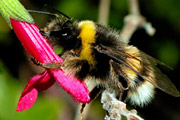Honey bees (Apis mellifera) are approximately 0.5 inches long with a fuzzy light brown to black appearance. Honey bees also have striped black and brown abdomens. They are considered to be one of the most beneficial insects because they pollinate the plants, produce bee’s wax, and produce honey.
The wild colonies of Honey bees exist in cavities similar to hollow trees. Domestic honey bees on the other hand live in manufactured hives. Additionally, a honey bee colony occupies the same nest year after year which continually makes the hive grow.
During various times throughout the year new Honey bee queens are produced. this often forces the previous queen and a few of her workers to leave the hive and create swarms. The process of swarming is when the bees are trying to find a new home. The risk of being stung is lower when the bees are swarming due to their vulnerability of not having a hive or their honey to protect.
Africanized honey bees (Apis mellifera scutellata) are slightly smaller in size than the European honey bee; however, only an expert can tell the two bees apart.
These particular bees are rather aggressive compared to the other European subspecies, i.e. they will defend their hive more rapidly. A small swarm of Africanized honey bees are able to take over an European honey bee hive by merely invading the hive and killing the European queen and replacing her with their own queen.
Solitary bees make up a large portion of the small bodied bees. They range to up to 0.5 inches long and are usually sweat bees, mining bees, and/or leaf-cutting bees. These bees mostly nest in the soil and most of them usually nest near one another. They nest where there is little vegetation.
Sweat bees actually got their name due to their attraction to individuals who are perspiring, however they rarely sting. Some of the species of mining bees are attracted in large numbers to swimming pools.
Controlling solitary bees is not desirable due to the fact that they pose little or no threat to humans, pets and livestock, and they are active pollinators of many plant food sources.





